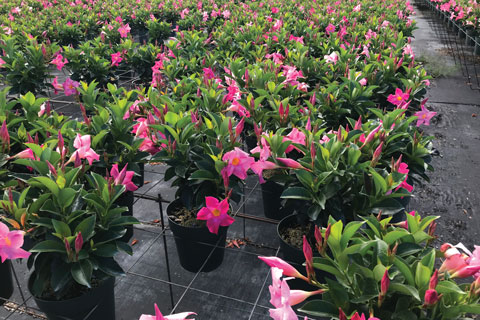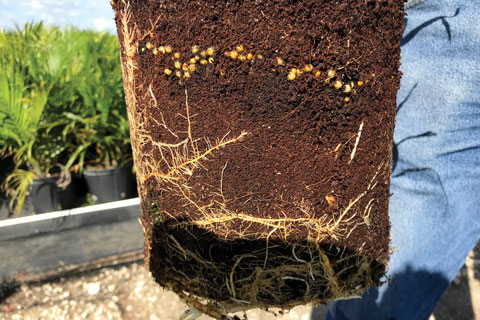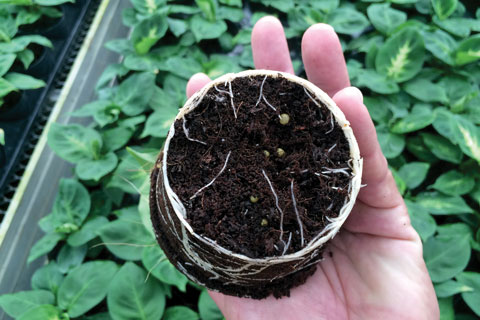8/1/2018
Fertilizer Refresher
Nelson Gonzalez
The advent of controlled-release fertilizer (CRF) has provided growers with numerous benefits, including ease of use, cost effectiveness, extended nutritional longevity, lower environmental impact and reduction in labor. The fact that one application of CRF can provide all the nutrition that a plant needs for an extended period of time provides growers the opportunity to focus on other aspects of production. But before a grower can reap the rewards of a truly optimized nutritional program, it’s necessary to determine which CRF to use, the correct rate, its longevity and how it will be applied.
There are four basic methods to apply CRFs: top-dress, dibble, sub-dress and incorporation. There are pros and cons to each, but it’s up to the grower to analyze each method, assess their individual needs and determine which method is best for their overall production goals. This article will explore each method of applying CRFs and help you to decide which is best for you.
 Top-dressing
Top-dressing
Top-dressing is the act of applying fertilizer to the media surface of a containerized plant. The simplicity of this method makes it attractive to many growers. Top-dressing provides the grower with an opportunity to quickly apply CRF and allows for a great amount of flexibility. With this method, growers can differentiate between fertilizer types and rates based on the needs and goals of a particular planting block.
Pictured: Top-dressing is when you apply fertilizer to the media surface of a containerized plant. With this method, growers can differentiate between fertilizer types and rates based on the needs and goals of a particular planting block.
On the flip side, there are a few disadvantages that should be taken into consideration when choosing to top-dress. For starters, top-dressing is more labor intensive than other methods and fertilizer can fall out of the container if the plant falls over. Also, plants that have been top-dressed may have increased weed pressure compared to other application methods.
And lastly, when growing plants in larger containers, if drip irrigation is utilized instead of overhead, fertilizer may not receive adequate water depending on the location of the top-dress application. This water is necessary to push nutrients through the media column and get to the roots. If you can’t apply the CRF directly under the drip emitter, a different method may be a better choice.
Dibble
The dibble method is used when stepping up liners to smaller containers. This method is performed by filling a container with media and then creating a hole in the media where the liner will be planted. CRF is then placed in the hole and the liner is planted on top of the fertilizer. One benefit of this method is that the close proximity of the liner to the fertilizer may allow for a slight reduction in the rate at which the fertilizer is applied.
Also, because the fertilizer is beneath the surface of the media, it makes it very difficult for CRF to fall out if the pot falls over and can also result in lower weed pressure. The reduction in weed pressure is primarily due to the fact that, as weeds germinate, they’re deprived of necessary nutrients as a result of the fertilizer being a few inches below the soil line.
This method can be very efficient, but it’s important to use caution when dibbling. Having a large concentration of fertilizer in close proximity to the roots may damage your plants, especially if the containers are allowed to dry out excessively between watering. If the dibble method is used, a trial on a small batch of each plant species should be conducted. Also, it’s recommended that a 100% coated, homogenous longer-term type of CRF be used.
 Sub-dressing
Sub-dressing
Sub-dressing is the method of applying CRF just beneath the surface of the media. When stepping up a plant to a larger container, a small amount of media (just enough for the top of the root ball to be level with what will be the media surface) is added. The container of the smaller plant is then removed and the plant is placed in the center of the larger container. Additional media is then added to fill the sides up to about 2 in. below what will be the media surface of the new, larger container. The CRF is then distributed evenly on the media, towards the outer edge of the larger container, away from the plant. And finally, additional media is applied over the fertilizer to finish filling the container.
Pictured: Sub-dressing is when you apply CRF just beneath the surface of the media. The greatest downside to this method is the additional labor needed.
The greatest downside to using the sub-dress method when applying CRF is that additional labor will be required compared to other methods. This ultimately increases overall cost, but in many cases, the additional expense and effort can be justified with improved performance and
efficacy.
For example, the sub-dress method may result in a reduction in the rate of application due to the strategic placement of the fertilizer. Placement beneath the media surface also can decrease the amount of weed pressure and, if a plant falls over, the probability of fertilizer falling out of the container is minimal. Also, much like top-dressing and dibbling, sub-dressing provides the grower with the flexibility to adjust the type and rate of CRF according to a plant’s needs.
The method of sub-dressing CRF is often overlooked, but merits consideration for any grower looking to improve their crop performance and efficiencies.
 Incorporation
Incorporation
Incorporation is a method in which CRF is blended into the media at the greenhouse or a media-blending facility. This method is both cost-effective and efficient because manual labor isn’t necessary to apply fertilizer during the potting process. In addition, with this method, if a plant falls over, the only fertilizer lost will be the small amount that falls out with the media. And if the media is replaced in the container, the fertilizer will go back with it.
Pictured: Incorporation is when CRF is blended into the media at the greenhouse or a
media-blending facility. This method is both cost-effective and efficient.
Incorporation is a great method for large plantings of a single plant type or different plants that require the same fertilizer and rate, in which case the media can be used up quickly. When using this method, media displacement should be taken into consideration. Media displacement occurs when stepping up a plant to a larger container. Essentially, the root ball takes up space in the new container that otherwise would have been fresh media and, more importantly, fresh fertilizer. This results in a reduction in the rate per container at which the fertilizer is applied and could lead to nutritional deficiencies, which will need to be corrected, adding to the overall cost of production.
One solution to counteract significant displacement is to apply additional fertilizer to your container during the planting process. This can be accomplished either by top-dressing or sub-dressing additional fertilizer to compensate for the displaced fertilizer. Be selective when supplementing in this manner, as it can be very time-consuming, defeating the purpose of using the incorporation method.
If the same rate can be used for all plants using an individual load, a better option might be to slightly increase the rate at which the CRF is incorporated. This would help compensate for the amount of fertilizer that’s displaced by the smaller root ball.
Regardless of whether the CRF is incorporated by the soil blender or done at the greenhouse by pad mixing, it’s imperative that procedures be put in place to ensure proper uniformity during the blending process and that the pre-determined target rates are actualized. Additionally, growing media that has CRF incorporated into it and kept in a pile should be used up in a timely manner to avoid ECs from building up, as well as wasting nutrients.
As previously stated, CRF can provide many benefits and opportunities. Growers should always take into consideration their available resources and production goals before deciding which application method is best for them. This up-front planning will ultimately save time and money and ensure greater success. GT
Nelson Gonzalez is Territory/Key Account Manager and Digital Media Lead for ICLSF Americas.